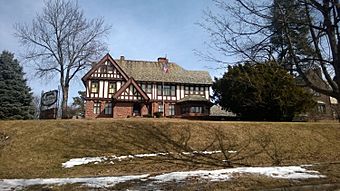Fifth Street Bluff Historic District facts for kids
Quick facts for kids |
|
|
Fifth Street Bluff Historic District
|
|
 |
|
| Location | Roughly bounded by Jefferson, E. 6th, Washington, and 4th Sts. Ottumwa, Iowa |
|---|---|
| Area | 23.5 acres (9.5 ha) |
| Architect | Edward Hammatt, et al |
| Architectural style | Tudor Revival Italianate Queen Anne |
| MPS | Ottumwa MPS |
| NRHP reference No. | 97001606 |
| Added to NRHP | January 7, 1998 |
The Fifth Street Bluff Historic District is a special area in Ottumwa, Iowa, United States. It's known for its history and beautiful old buildings. This district is recognized across the country as a historic place.
It was added to the National Register of Historic Places in 1998. When it was first listed, the district had 67 important features. These included 40 buildings that add to its history. There were also three important structures and 24 other buildings.
A Look Back at the Fifth Street Bluff
As the city of Ottumwa grew in the mid-1800s, many wealthy people wanted to build homes. They chose the bluff overlooking the town. This spot offered amazing views of the Des Moines River Valley. It also kept them away from the swampy areas near the river.
Building in this part of the city started in the 1850s. However, most of the development happened during three main times. These were the 1860s, the 1890s, and the 1920s.
Many important people built their homes here. These included George Morrell, who was part of John Morrell & Company. Other notable residents were F.W. Simmons from American Mining Tools Company and G.C. Janney of Janney Manufacturing. J.W. Edgerly, a wholesale druggist, and J.H. Merrill, a wholesale grocer, also lived here. Judge H.B. Hendershott was another famous resident. Most of the construction in this area was finished by 1930.
In 1895, the streets in the district were paved with bricks. They were also lined with beautiful limestone.
Amazing Architecture and Design
Because of its location on a bluff, this area is mostly for homes. There aren't many shops or businesses here. The district has some of the best examples of different building styles in Ottumwa. It also has the most houses and buildings designed by famous architects.
Nine different architects helped design buildings in the district. One was George M. Kerns, an architect from Ottumwa. F.R. Comstock, from New York City, also contributed. Edward Hammatt from Davenport and the firm Fisher & Lowrie from Omaha also designed buildings.
You can see many popular architectural styles here. These include Italianate, Queen Anne, and Tudor Revival.
Two historic churches are also in the district: First Baptist and Trinity Episcopal. The district also includes special structures like the brick streets, stone walls that hold back the earth, and an old iron fence. Two homes, the Foster/Bell House and the Jay Funeral Home, are so important they are listed separately on the National Register of Historic Places.



